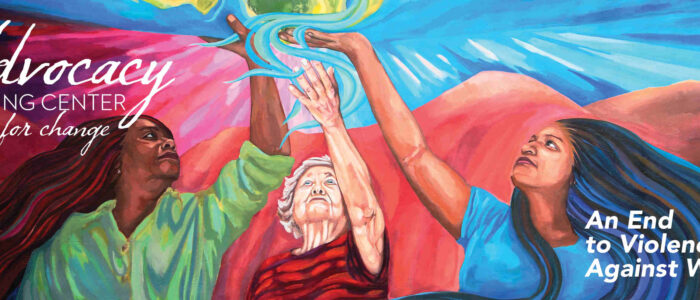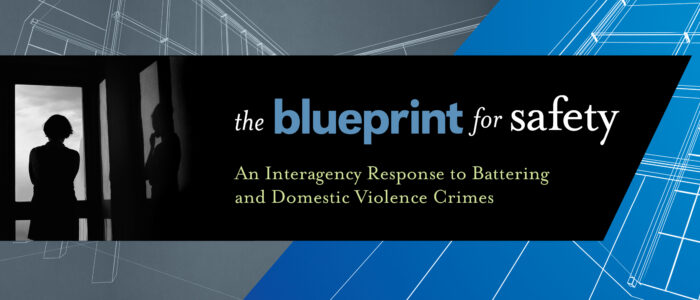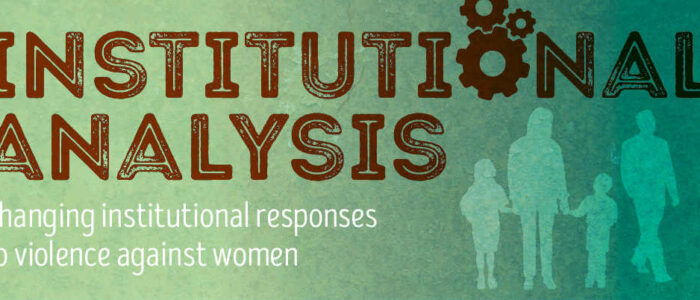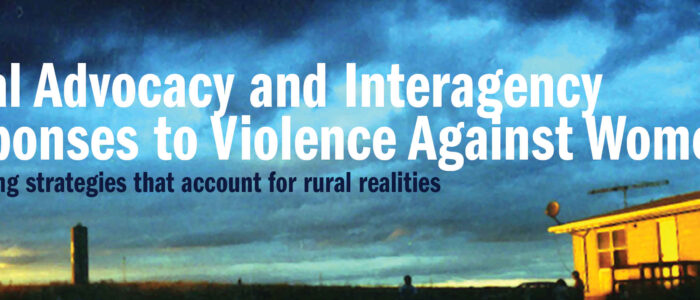- General
- Commitments
- FAQ
Developed by the City of Saint Paul, Praxis International, and the Saint Paul Domestic Abuse Intervention Project, the Blueprint for Safety is an innovative approach in criminal justice intervention to protect victims of battering and end intimate partner violence. It is a comprehensive response to domestic violence crimes, based on thirty years of community practice and research.
“Across the country, we have learned the hard way that great harm and tragedy can occur when criminal justice agencies do not coordinate their interventions on multiple levels of information gathering and sharing or do not use sound intervention approaches. The criminal justice system has the ultimate obligation to keep communities safe, yet its sheer size and complicated structure can prevent domestic violence cases from being handled as effectively as they could be. The Blueprint changes this.”
Bea Hanson, Principal Deputy Director, Office on Violence Against Women – Remarks delivered at launch of New Orleans Blueprint for Safety, October 21, 2014
Using the Blueprint, a coordinated justice system responds to domestic violence offenses more quickly and effectively, enhancing its capacity to stop violence, reduce harm, and save lives.
 The Blueprint:
The Blueprint:
- Improves how agencies share information, from 911 operators to police and prosecuting attorneys to courts and probation
- Ensures risk is properly assessed and responded to at every step
- Encourages new victim engagement strategies
- Pays attention to reducing unintended negative impacts on survivors and their communities
- Creates a new way for agencies to work together to identify problems and find solutions that increase protections for victims
 Is your community ready for the Blueprint?
Is your community ready for the Blueprint?
- Read about the Essential Commitments of a Blueprint Community
- Find answers to Frequently Asked Questions
- Contact us for more information: Email info@praxisinternational.org
 Self-examination and problem-solving
Self-examination and problem-solving
The Blueprint is about finding and fixing problems in the criminal legal system response to domestic violence crimes. It provides best-practice templates that articulate how agencies can more effectively aid and protect victims of ongoing abuse, hold offenders accountable, and further the goal of public safety. In a Blueprint community, criminal justice system agencies partner with community-based advocacy to check practices against the Blueprint standards and to identify and solve problems together. Agencies commit to a process of ongoing supervision and monitoring to sustain the Blueprint and adjust to unforeseen or new problems in their response.
 Blueprint foundational principles
Blueprint foundational principles
Six foundation principles are fundamental to how the Blueprint functions.
- Adhere to an interagency approach and collective intervention goals
- Build attention to context and severity of abuse into each intervention
- Recognize that most domestic violence is a patterned crime requiring continuing engagement with victims and offenders
- Ensure sure and swift consequences for continued abuse
- Send messages of help to victims and messages of accountability to offenders
- Act in ways that reduce unintended consequences and the disparity of impact on victims and offenders
The principles carry the essence of the Blueprint. In a Blueprint community, the major criminal justice agencies agree that the foundational principles will guide the response at each step.
 A central role for community-based advocacy in Blueprint leadership and partnerships
A central role for community-based advocacy in Blueprint leadership and partnerships
The Blueprint is distinctive in its emphasis on leadership by community-based advocacy organizations with a history of legal systems advocacy to individual victims of battering and experience in improving the legal system response.
The Blueprint calls on advocacy organizations and criminal justice agencies to work together to develop procedures and protocols. It also calls for including and consulting with those in the community who are most impacted by such public policies. Along with practitioner-advocate partnerships, a Blueprint community engages with a range of community members, from victims and survivors to populations overrepresented and/or underserved in the system, to develop, implement, and monitor Blueprint policies and practice.
Show MoreCommunity-based advocacy located in nonprofit, nongovernmental or tribal organizations, such as a local program for battered women, is essential to grounding the Blueprint in the scope and scale of domestic violence and in victims’ lives and experiences. One way this can happen is to establish and maintain an advisory group of survivors who can help direct the process of adapting and implementing the Blueprint.
Community-based advocacy provides a setting where victims of battering can speak confidentially, freely, and openly. No one else plays this role, which is distinct from that of the important support provided by victim assistance or legal services within government agencies. Community-based advocacy typically has broader access to victims and survivors, many of whom are fearful of and try to avoid public institutions such as the criminal legal system. Research reinforces the value of the advocacy initiated response reflected in the Blueprint in improving court outcomes in domestic violence-related cases.
Read below for answers to frequently asked questions about the Blueprint for Safety:
 What is distinctive about the Blueprint?
What is distinctive about the Blueprint?
The Blueprint is a coordinated community response (CCR) fully formed and actualized. It builds on the pioneering work of two Minnesota communities, Saint Paul and Duluth, to present the first comprehensive, written interagency plan in the nation for the criminal legal system response to domestic violence crimes, from 911 through sentencing and probation. It unites each step in the process around consistent identification and communication of risk. The Blueprint is grounded in the experiences of victims of battering and understanding of how intervention by the criminal legal system affects their lives.
Show MoreIt establishes an ongoing process of reviewing, monitoring, and adjusting policy and practice to ensure the most protective and accountable response possible, from an emergency call for help through to sentencing and probation. The Blueprint organizes case processing around: 1) what victims need to be safe; 2) what practitioners need from each other to do their jobs and enhance safety; and 3) what is required by each worker and agency to hold offenders accountable. It requires adjusting interventions in ways that avoid and correct unintended harmful consequences and disparity of impact.
 Do we have to have a CCR in place? Who needs to be on board?
Do we have to have a CCR in place? Who needs to be on board?
The Blueprint is an interagency response, guided by community-based advocacy: i.e., it is fundamentally a coordinated community response, but a fully formed CCR. A functioning interagency group and/or process that includes community-based advocacy and key agencies in the criminal legal system response is necessary to adapt and sustain the Blueprint. Starting out to develop a local Blueprint does not mean that every criminal legal system agency has to be fully on board and engaged.
Show MoreThe Blueprint is unlikely to get far, however, without the early and continuous involvement of the community-based advocacy program, police, and prosecution. A community with a longstanding, well-functioning CCR will be able to move from adaptation to implementation more readily. If agreement among key players is in place, a community without an established CCR can also use the process of adapting the Blueprint to create a coordinated community response in the criminal legal system.
 What are the key steps?
What are the key steps?
Adapting the Blueprint for Safety involves six major steps:
- Secure community will
- Establish a Blueprint adaptation team
- Assess current policy and practice
- Write Blueprint policies and protocols
- Launch and implement the Blueprint changes
- Monitor Blueprint changes and compliance
The work proceeds in two phases. Phase one involves establishing the community and political will to develop and sustain the Blueprint, assessing current practice, and adapting the Blueprint policy and protocol templates and training memos to local conditions and state or tribal laws. Phase two takes the Blueprint from a written document to a living practice when each agency implements, complies with, and maintains its shared philosophy and collective policies.
 Who does the work? Do we need a coordinator?
Who does the work? Do we need a coordinator?
Adapting the Blueprint requires community-based advocates, agency administrators, practitioners who handle cases in their everyday jobs, a local Blueprint coordinator, and various community partners. Those involved come together in different ways, depending on the needs at different steps in the process. Champions get involved early on and at key points in launching, promoting, and sustaining the Blueprint. Champions might include agency administrators, such as the chief of police or prosecutor; elected officials such as the sheriff or mayor or tribal chair; and influential community members, such as members of the tribal council or the United Way or YWCA director. Except in small communities, Blueprint champions typically do not do the day-to-day work of adapting and implementing the Blueprint. Blueprint champions are key to securing the community and political will necessary to proceed and to securing the memorandum of understanding that defines each agency’s participation.
Show MoreThe Blueprint team provides ongoing guidance and participates in activities related to assessing practice, adapting policies, launching and implementing the Blueprint, and establishing and managing a monitoring process. The Blueprint team includes practitioners who are decision-makers or otherwise influential in their agencies. Once the policies and protocols have been adapted and launched, many of the same individuals who were involved in the first phase are likely to participate on the implementation team. Ad hoc work groups come together as needed to collect data about current practice, review and revise policies and protocols, and monitor Blueprint changes. The Blueprint coordinator manages the day-to-day tasks of adapting the Blueprint and links everyone involved to the overall process. The coordinator keeps the focus on managing the parts and advancing the Blueprint from design to implementation.
Do you need a coordinator? Yes.
 How much does it cost?
How much does it cost?
Salary and fringe benefits for the Blueprint coordinator and participation of one or more community-based advocates are the main costs in adapting the Blueprint. Other expenses include: office space and equipment; costs involved in recruiting and facilitating a survivor’s advisory group and community focus groups; training and launch events; printing and distributing Blueprint documents; developing and maintaining databases, web-site, revised forms, and other tools.
 How do we sustain the Blueprint?
How do we sustain the Blueprint?
Sustaining the Blueprint requires ongoing coordination and an ongoing process of institutionalizing the Blueprint. That process includes integrating Blueprint policies and protocols into each agency’s practice; training personnel; establishing an interagency communication strategy for sharing information about risk, history, context, and severity of violence; monitoring implementation and compliance; and adapting the Blueprint to address unforeseen and new problems. Sustaining the Blueprint requires commitments from agency administrators to develop and activate internal and inter-agency compliance and monitoring plans.
 How do we know if the Blueprint is the best step for our community?
How do we know if the Blueprint is the best step for our community?
If you can answer “yes” to the following qualities, your community is in a good position to design and implement a Blueprint for Safety.
Show More- Community-based advocates have a central role in commenting on and shaping the criminal legal system’s response to domestic violence.
- Community-based advocates and key leaders in the criminal legal system are accustomed to working together to identify and solve problems.
- We are curious and transparent about our response to domestic violence crimes.
- We seek out best practice rather than assuming that what we have been doing is the most effective approach.
- We are committed to a united approach with a shared purpose and goals.
- We can agree upon adhering to the Blueprint foundational principles to guide the response to domestic violence crimes.
- We can establish the necessary coordination.
- We can establish sufficient authority and resources to sustain the Blueprint.
 What if we can’t take on the entire Blueprint?
What if we can’t take on the entire Blueprint?
Show More How can we prepare to write a grant to develop the Blueprint for Safety in our community?
How can we prepare to write a grant to develop the Blueprint for Safety in our community?
The discussions, groundwork, and information gathering included in Planning a Blueprint for Safety Proposal help position a community to submit a grant for funding to develop and launch the Blueprint. In addition, many of the questions lead to the kinds of reflection that benefit any coordinated inter-agency effort.
 How do we learn more?
How do we learn more?
If you are interested in becoming a Blueprint for Safety community—or wondering if you’re ready for the Blueprint—contact Praxis International.
Show MoreGo to www.praxisinternational.org for general information and announcements of upcoming Blueprint webinars and events.
Write to info@praxisinternational.org to request a phone consultation





